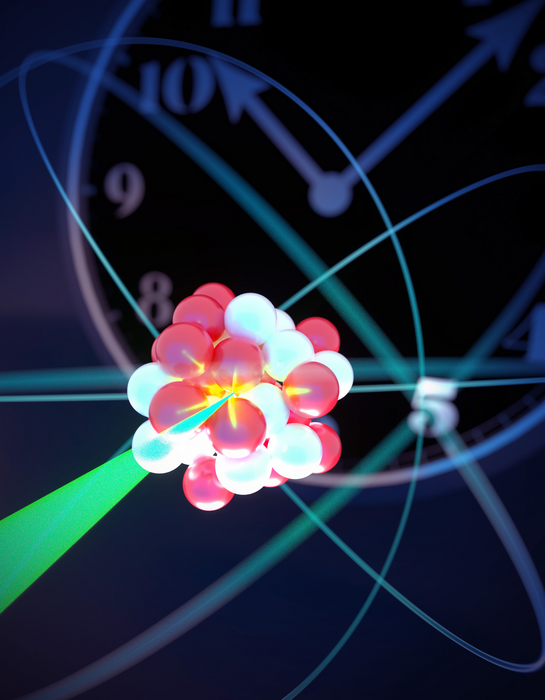In the cosmos, highly charged ions are a usual form of matter. They can be found, for instance, in the sun and other stars. They gained their name because they have lost a lot of electrons and have a lot of positive charges. This is why the outermost electrons in neutral or weakly charged atoms are more tightly bonded to the atomic nucleus.

Illustration of the laser interrogation of a highly charged ion clock (artwork). Image Credit: Physikalisch-Technische Bundesanstalt.
As a result, highly charged ions are less vulnerable to interference from external electromagnetic fields while also becoming more sensitive probes of fundamental effects of special relativity, quantum electrodynamics, and the atomic nucleus.
Therefore, we expected that an optical atomic clock with highly charged ions would help us to better test these fundamental theories. We were able to detect the quantum electrodynamic nuclear recoil, an important theoretical prediction, in a five-electron system, which has not been achieved in any other experiment before.
Lukas Spieß, Physicist, Physikalisch-Technische Bundesanstalt
Previously, the group had to work for years to tackle certain essential challenges like detection and cooling. Atomic clocks require considerable cooling to halt the particles as much as possible and hence read out their frequency at rest. However, highly charged ions are generated by creating extremely hot plasma.
Highly charged ions cannot be directly cooled with laser light due to their extreme atomic structure, and typical detection methods are also ineffective. Teamwork between MPIK in Heidelberg and the QUEST Institute at PTB solved this problem by extracting a single highly charged argon ion from hot plasma and trapping it in an ion trap with a singly charged beryllium ion.
This enables the highly charged ion to be indirectly cooled and analyzed using the beryllium ion. The subsequent experiments were carried out in part by students switching between the institutions, using an advanced cryogenic trap system created at MPIK and perfected at PTB.
Following that, a quantum algorithm created at PTB excelled in further cooling the highly charged ion, bringing it close to the quantum mechanical ground state. This equated to a temperature of 200 millionths of a kelvin above absolute zero. These findings were reported earlier in the journal Nature in 2020 and Physical Review X in 2021.
The following phase has been successfully completed by the investigators, who created an optical atomic clock depending on thirteen-fold charged argon ions and contrasted the ticking to the ytterbium ion clock already in place at PTB.
To accomplish this, they had to conduct a thorough analysis of the system to comprehend things like the highly charged ion's movement and the impacts coming from external interference fields. They were able to attain measurement uncertainty of 2 parts in 1017, which is equivalent to several optical atomic clocks that are now in use.
We expect a further reduction of the uncertainty through technical improvements, which should bring us into the range of the best atomic clocks.
Piet Schmidt, Research Group Leader, Physikalisch-Technische Bundesanstalt
As a result, scientists have created a credible competitor to existing optical atomic clocks based on individual ytterbium ions or neutral strontium atoms. The procedures used are globally applicable and allow for the investigation of a wide range of highly charged ions. Atomic systems can be utilized to look for extensions to the Standard Model of particle physics.
Other highly charged ions are especially sensitive to changes in the fine structure constant and to specific dark matter candidates that are needed in models beyond the Standard Model but could not be identified using existing approaches.
Journal Reference
King, S. A., et al. (2022) An optical atomic clock based on a highly charged ion. Nature. doi.org/10.1038/s41586-022-05245-4.